| Author |
Message |
Kurt Gerhard Studenroth

Location: Springfield, Oregon Joined: 16 Apr 2008
Posts: 5
|
 Posted: Fri 02 Dec, 2011 1:54 am Post subject: The Gorget Posted: Fri 02 Dec, 2011 1:54 am Post subject: The Gorget |
 |
|
I know this question might be superfluous but I have been reading Arms & Armor of the Medieval Knight by David Edge and John Miles Paddock for the last two weeks, now, and perusing other sources and have yet to find a satisfactory answer.
Arms & Armor goes from the great helm to the bascinet and the aventail in the 14th century to kettle hats and sallets and bevors in the 15th; it seems to me that mail started transitioning to plate somewhere at the start of the 1300s beginning with such things as poleyns, cops, and coats of plate but nowhere do I ever seem to be given a definitive manifest of when gorgets first start appearing.
I was hoping someone could enlighten me on this matter.
"Young knights learn to love God and honor women that your honor may grow. Practice knightly things and learn arts that help you and grant you honor in war. This you shall know, that all things have length and measure. Do what you wish to do with good understanding. Never give an advantage for nothing. He is a brave man who fights his own weaknesses. Do not strike at the sword but wait for the openings." — Liechtenauer
|
|
  |
 |
|
Adam Bodorics
Industry Professional
|
 Posted: Fri 02 Dec, 2011 3:27 am Post subject: Posted: Fri 02 Dec, 2011 3:27 am Post subject: |
 |
|
Mail standards and mantles were used even in the 16th century, and the earliest clearly depicted separate articulated gorget I found dates to 1445. But as grand bascinets are shown with articulated necks and kettle hats with 360° coverage "bevor-gorgets" much earlier, it seems obvious that separate gorgets were possibly used by then, just not so popular (also there are probably far more paintings that I didn't see yet). Based on what I've seen, they became widespread in about the first half of the 16th century, possibly due to weight increase in cuirasses - gorgets make excellent load bearing platforms.
Also, this leaves out non-articulated gorgets. I don't really know anything about those, except they were certainly used at the end of the 14th century.
 Attachment: 188.17 KB Attachment: 188.17 KB
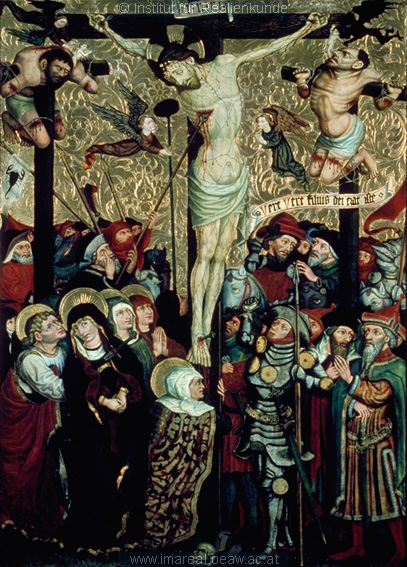
From 1445
 Attachment: 185.24 KB Attachment: 185.24 KB
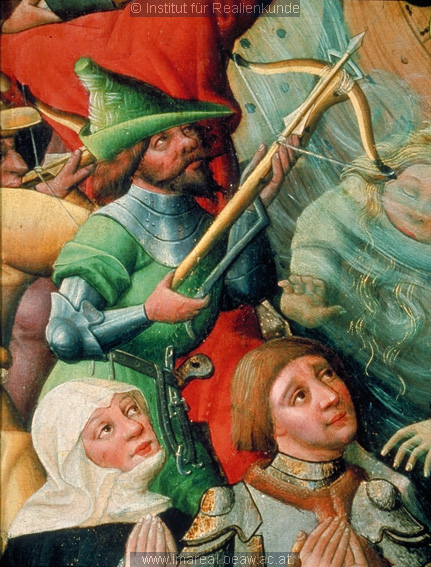
From 1448
|
|
  |
 |
|
Sam Gordon Campbell
Location: Australia. Joined: 16 Nov 2008
Posts: 678
|
 Posted: Fri 02 Dec, 2011 4:48 am Post subject: Posted: Fri 02 Dec, 2011 4:48 am Post subject: |
 |
|
Well I know that one of the knights on the Wells Cathedral (circa 1240 apparently) appears to have what might be construed as some sort of form of rigid/semi-rigid external neck defense.
Member of Australia's Stoccata School of Defence since 2008.
Host of Crash Course HEMA.
Founder of The Van Dieman's Land Stage Gladiators.
|
|
  |
 |
Iagoba Ferreira

|
 Posted: Sat 03 Dec, 2011 1:09 pm Post subject: Posted: Sat 03 Dec, 2011 1:09 pm Post subject: |
 |
|
There are several statues from the kingdoms of Navarra, Castilla and Aragón showing rigid plate gorgets (some clearly made from several plates riveted) in the early XIVth century. There are photos and drawings in the Osprey book about the Reconquista.
Mail standards are useful if you wear a helmet that "ends" quite low (like a barbuta), so you cannot wear a bevor. I've read recently that they were typically English, but they were aplenty in any other part of the continent by the evidences.
|
|
  |
 |
Mackenzie Cosens

Location: Vancouver Canada Joined: 08 Aug 2007
Posts: 238
|
|
  |
 |
Mackenzie Cosens

Location: Vancouver Canada Joined: 08 Aug 2007
Posts: 238
|
 Posted: Sun 04 Dec, 2011 1:44 am Post subject: Posted: Sun 04 Dec, 2011 1:44 am Post subject: |
 |
|
extent 14C armour that might have a gorget plate but likely its another cote of plate plate.
and a couple of high status 14C Englishman with gorgets.
note: thank you to who ever posted these images on the web.
mackenzie
 Attachment: 61.83 KB Attachment: 61.83 KB
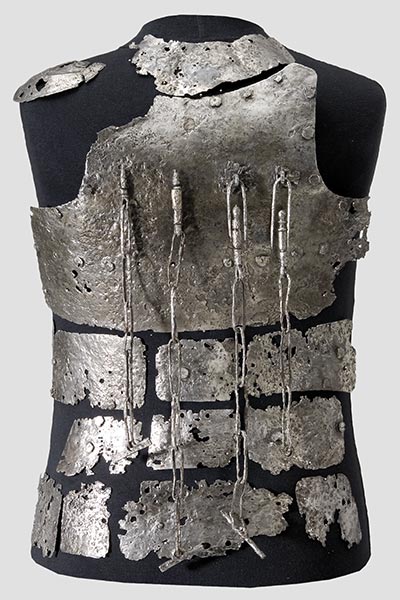
my guess mid 14thC German with maybe a possible gorget plate but likely just a COP plate
 Attachment: 78.54 KB Attachment: 78.54 KB
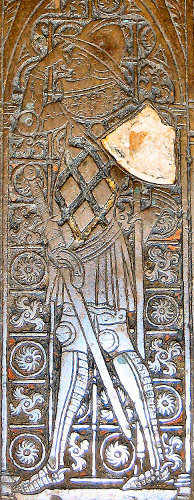
1340ish English High status
 Attachment: 71.42 KB Attachment: 71.42 KB

an other high status Englishman
|
|
  |
 |
Iagoba Ferreira

|
 Posted: Sun 04 Dec, 2011 3:24 pm Post subject: Posted: Sun 04 Dec, 2011 3:24 pm Post subject: |
 |
|
| Quote: | | I think this is Spanish possible gorgets |
Those are part of a series of wall paintings that were on the "Saló del Tinell" in Barcelona.
|
|
  |
 |
|
Jojo Zerach
|
 Posted: Sun 04 Dec, 2011 7:31 pm Post subject: Posted: Sun 04 Dec, 2011 7:31 pm Post subject: |
 |
|
A form of bevor appears in the early 14th century, but falls out of favour by 1350.
(As for true gorgets, I don't know when they appeared.)
1322, Spain.

1330, France

1340, England

There is also this (French, circa 1330.)
I've seen scattered examples of these, it seems a bit closer to later gorgets than the ones above..

|
|
  |
 |
Mackenzie Cosens

Location: Vancouver Canada Joined: 08 Aug 2007
Posts: 238
|
 Posted: Mon 05 Dec, 2011 12:17 pm Post subject: Posted: Mon 05 Dec, 2011 12:17 pm Post subject: |
 |
|
| Iagoba Ferreira wrote: | | Quote: | | I think this is Spanish possible gorgets |
Those are part of a series of wall paintings that were on the "Saló del Tinell" in Barcelona. |
Thanks! I can start building back my metadata
mackenzie
|
|
  |
 |
Randall Moffett

|
|
  |
 |
|
Roderick Stacey
|
 Posted: Mon 05 Dec, 2011 6:54 pm Post subject: Posted: Mon 05 Dec, 2011 6:54 pm Post subject: |
 |
|
The mack also has some higher status guys with collars too! such as the king, there are a few wearing collars under the maille too.
My wife made herself a padded collar, we think that they were like a gambeson (cloth) or potentially even a strip of metal with padding.
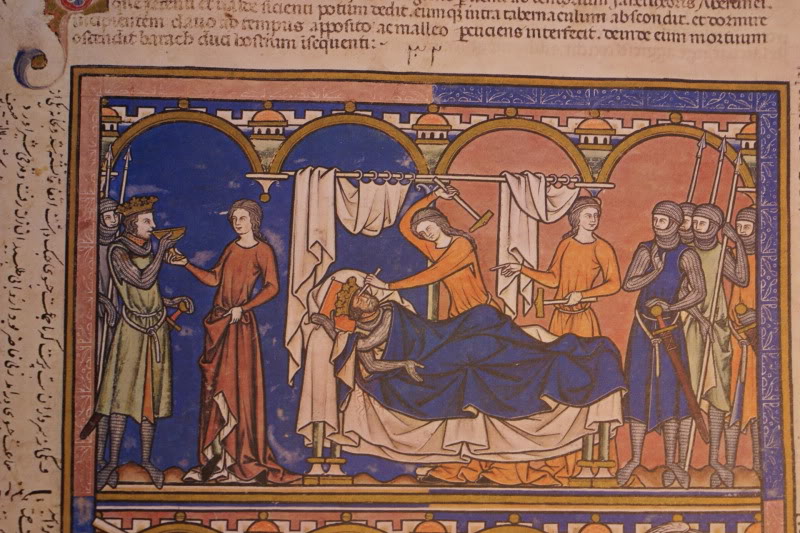
|
|
  |
 |
|
Sam Gordon Campbell
Location: Australia. Joined: 16 Nov 2008
Posts: 678
|
 Posted: Mon 05 Dec, 2011 10:00 pm Post subject: Posted: Mon 05 Dec, 2011 10:00 pm Post subject: |
 |
|
I have tested both stuffed and quilted collars (buffs?) and my thoughts are thus:
- If you want rigid neck protection without the addition of plates of either hardened leather or iron, then vertically stuffed is the way. It cradles your head and would help resist whiplash. However, as it has little to no vertical compression, you can forget trying to nod. Works on either the outside or inside of maille, the trade of being that you loose definition in your neck.
- If you want streamlined however, quilted is the way to go. It offers some padding and means that one can move ones head more or less normally. Goes very well underneath. The trade off is that in my view it doesn't offer any 'crush' protection, so being hit with a sword is okay, but coming of your horse or being hit with a mace or axe... Well. It won't end well.
-Make them shorter then you think you'll need them. They tend to ride up onto the aketon or gambeson and thus raise themselves.
Another example can be found here.
 Attachment: 180.78 KB Attachment: 180.78 KB
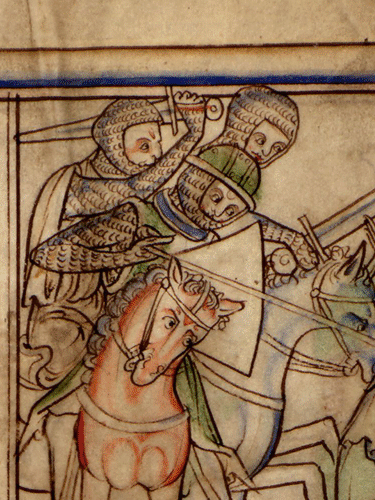
Matthew Paris.
Member of Australia's Stoccata School of Defence since 2008.
Host of Crash Course HEMA.
Founder of The Van Dieman's Land Stage Gladiators.
|
|
  |
 |
Randall Moffett

|
 Posted: Tue 06 Dec, 2011 5:05 am Post subject: Posted: Tue 06 Dec, 2011 5:05 am Post subject: |
 |
|
Roderick,
Could be an aketon peeking out as well.
RPM
|
|
  |
 |
|
Roderick Stacey
|
 Posted: Wed 07 Dec, 2011 5:26 am Post subject: Posted: Wed 07 Dec, 2011 5:26 am Post subject: |
 |
|
| Randall Moffett wrote: | Roderick,
Could be an aketon peeking out as well.
RPM |
Could be too, but some people in the mack have no collars too, so its open to interpretation.
In our group we think that it possible that it may be the case. Once I get my wife's maille coif done, I am looking forward to see it its comfortable to wear a padded collar under maille.
|
|
  |
 |
Randall Moffett

|
 Posted: Wed 07 Dec, 2011 5:49 am Post subject: Posted: Wed 07 Dec, 2011 5:49 am Post subject: |
 |
|
I agree. Certainly could be.
The only issue I have seen with the lone padded collar under the mail is is moves a great deal unless it is fairly snug/tight.Several people who wore them found this constricting while fighting.
RPM
|
|
  |
 |
|
|

